Strategic Financial Management: Financial Performance, Working Capital Management, and Sources of Funding
VerifiedAdded on 2023/06/10
|15
|5210
|170
AI Summary
This report covers the financial performance analysis of Unilever and Royal Dutch Shell, working capital management, and sources of funding for business expansion. It also includes financial appraisal methods and recommendations for Penco. The report defines the need for short-term and long-term working capital and discusses the pros and cons of various sources of funding such as loans, bank overdraft, debt capital, and equity capital. Subject: Strategic Financial Management, Course Code: N/A, Course Name: N/A, College/University: N/A
Contribute Materials
Your contribution can guide someone’s learning journey. Share your
documents today.
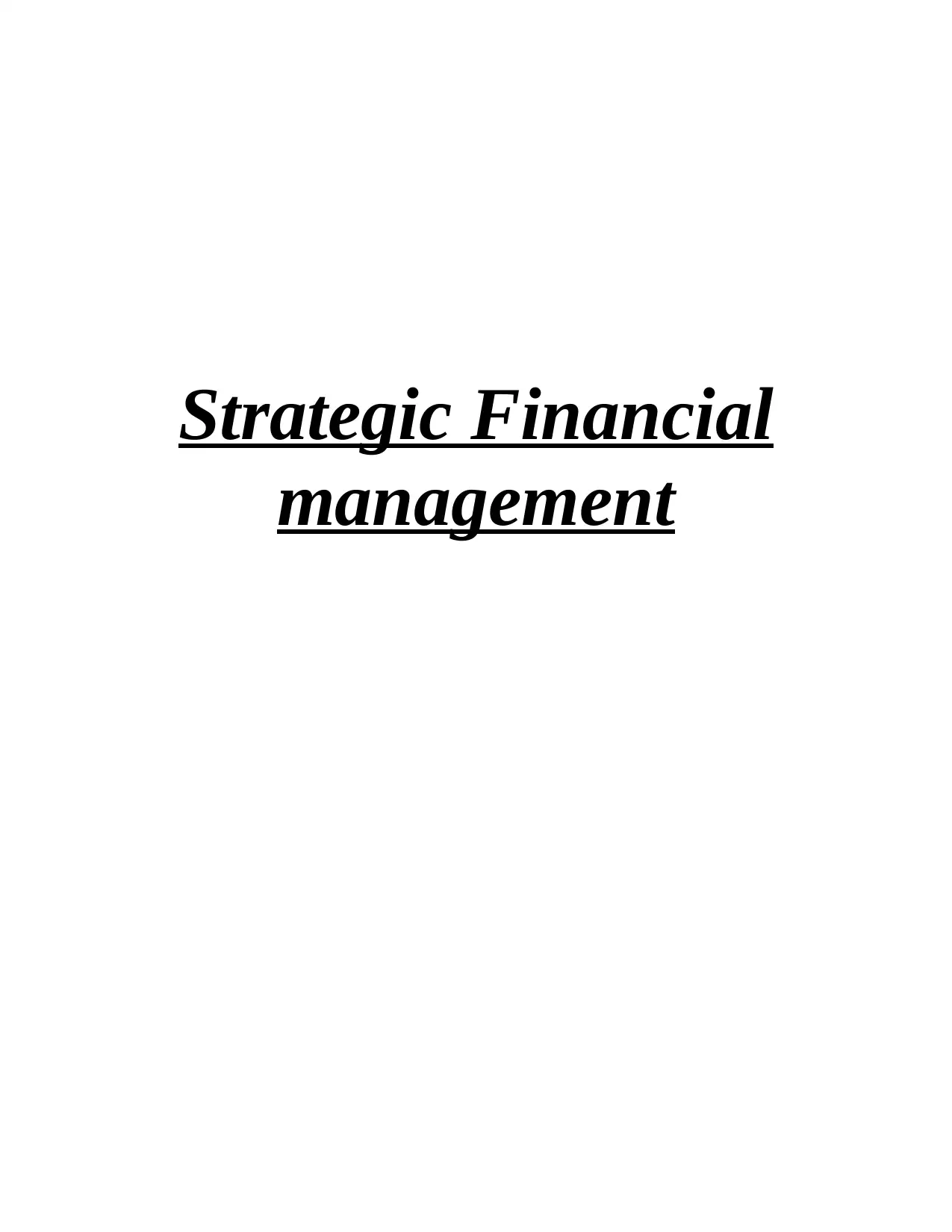
Strategic Financial
management
management
Secure Best Marks with AI Grader
Need help grading? Try our AI Grader for instant feedback on your assignments.
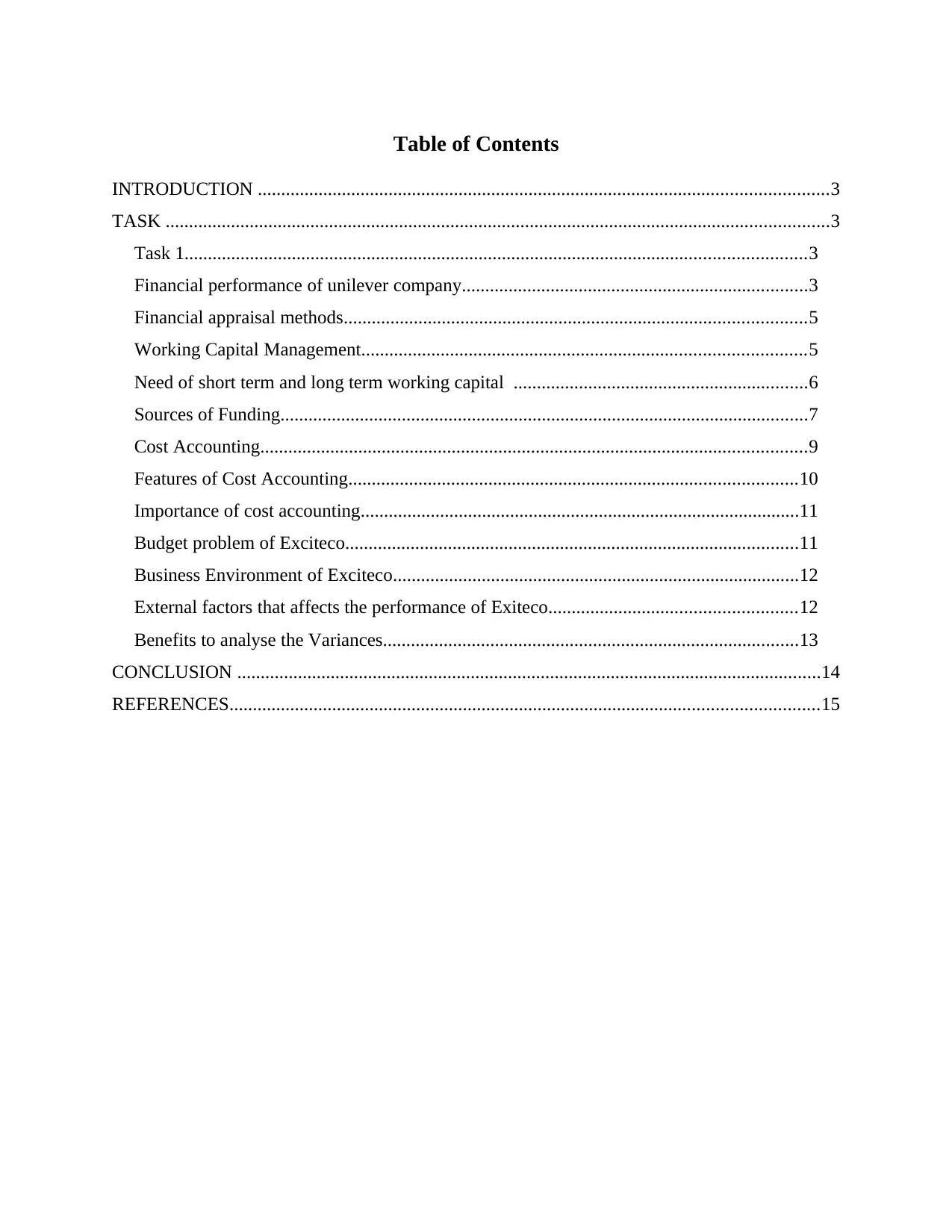
Table of Contents
INTRODUCTION ..........................................................................................................................3
TASK ..............................................................................................................................................3
Task 1.....................................................................................................................................3
Financial performance of unilever company..........................................................................3
Financial appraisal methods...................................................................................................5
Working Capital Management...............................................................................................5
Need of short term and long term working capital ...............................................................6
Sources of Funding.................................................................................................................7
Cost Accounting.....................................................................................................................9
Features of Cost Accounting................................................................................................10
Importance of cost accounting..............................................................................................11
Budget problem of Exciteco.................................................................................................11
Business Environment of Exciteco.......................................................................................12
External factors that affects the performance of Exiteco.....................................................12
Benefits to analyse the Variances.........................................................................................13
CONCLUSION .............................................................................................................................14
REFERENCES..............................................................................................................................15
INTRODUCTION ..........................................................................................................................3
TASK ..............................................................................................................................................3
Task 1.....................................................................................................................................3
Financial performance of unilever company..........................................................................3
Financial appraisal methods...................................................................................................5
Working Capital Management...............................................................................................5
Need of short term and long term working capital ...............................................................6
Sources of Funding.................................................................................................................7
Cost Accounting.....................................................................................................................9
Features of Cost Accounting................................................................................................10
Importance of cost accounting..............................................................................................11
Budget problem of Exciteco.................................................................................................11
Business Environment of Exciteco.......................................................................................12
External factors that affects the performance of Exiteco.....................................................12
Benefits to analyse the Variances.........................................................................................13
CONCLUSION .............................................................................................................................14
REFERENCES..............................................................................................................................15
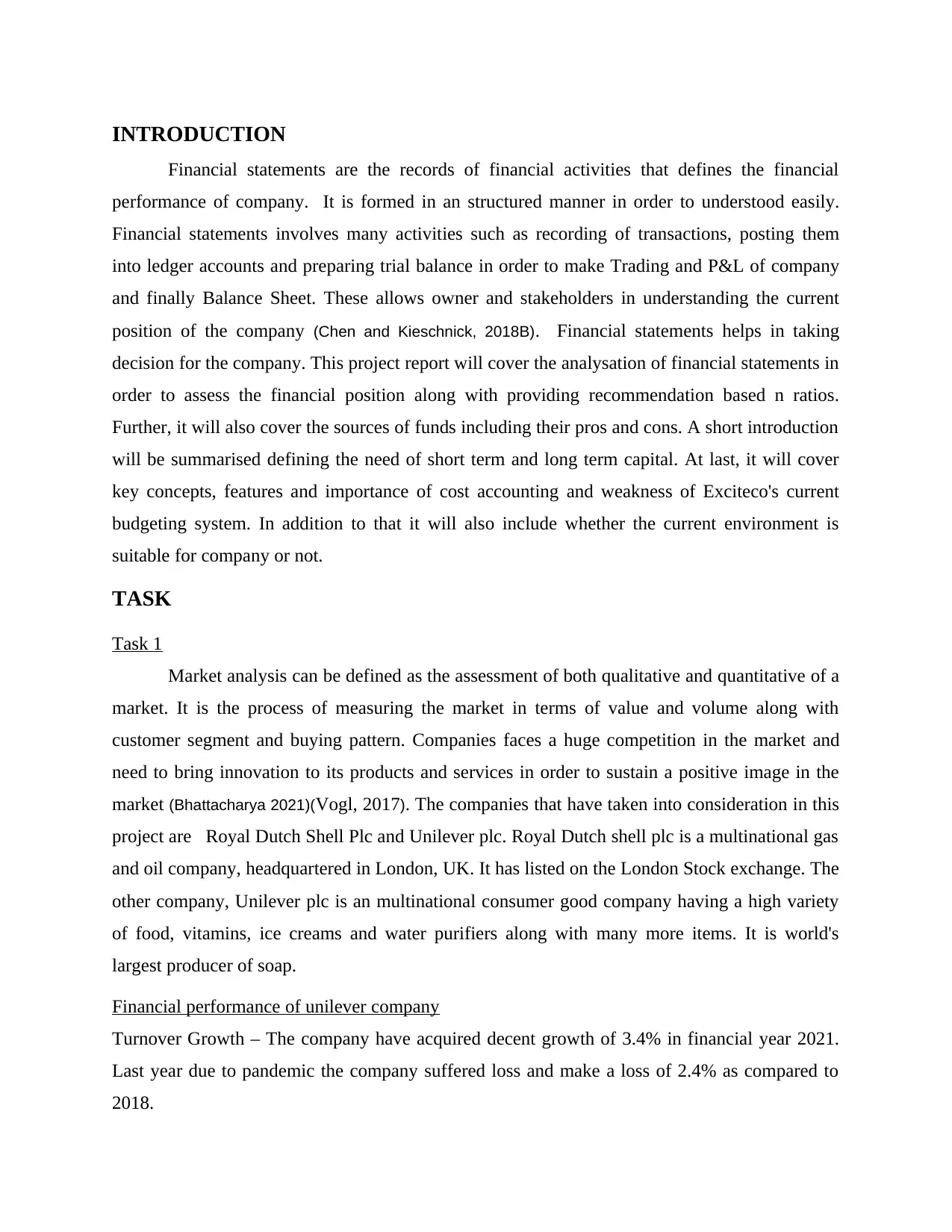
INTRODUCTION
Financial statements are the records of financial activities that defines the financial
performance of company. It is formed in an structured manner in order to understood easily.
Financial statements involves many activities such as recording of transactions, posting them
into ledger accounts and preparing trial balance in order to make Trading and P&L of company
and finally Balance Sheet. These allows owner and stakeholders in understanding the current
position of the company (Chen and Kieschnick, 2018B). Financial statements helps in taking
decision for the company. This project report will cover the analysation of financial statements in
order to assess the financial position along with providing recommendation based n ratios.
Further, it will also cover the sources of funds including their pros and cons. A short introduction
will be summarised defining the need of short term and long term capital. At last, it will cover
key concepts, features and importance of cost accounting and weakness of Exciteco's current
budgeting system. In addition to that it will also include whether the current environment is
suitable for company or not.
TASK
Task 1
Market analysis can be defined as the assessment of both qualitative and quantitative of a
market. It is the process of measuring the market in terms of value and volume along with
customer segment and buying pattern. Companies faces a huge competition in the market and
need to bring innovation to its products and services in order to sustain a positive image in the
market (Bhattacharya 2021)(Vogl, 2017). The companies that have taken into consideration in this
project are Royal Dutch Shell Plc and Unilever plc. Royal Dutch shell plc is a multinational gas
and oil company, headquartered in London, UK. It has listed on the London Stock exchange. The
other company, Unilever plc is an multinational consumer good company having a high variety
of food, vitamins, ice creams and water purifiers along with many more items. It is world's
largest producer of soap.
Financial performance of unilever company
Turnover Growth – The company have acquired decent growth of 3.4% in financial year 2021.
Last year due to pandemic the company suffered loss and make a loss of 2.4% as compared to
2018.
Financial statements are the records of financial activities that defines the financial
performance of company. It is formed in an structured manner in order to understood easily.
Financial statements involves many activities such as recording of transactions, posting them
into ledger accounts and preparing trial balance in order to make Trading and P&L of company
and finally Balance Sheet. These allows owner and stakeholders in understanding the current
position of the company (Chen and Kieschnick, 2018B). Financial statements helps in taking
decision for the company. This project report will cover the analysation of financial statements in
order to assess the financial position along with providing recommendation based n ratios.
Further, it will also cover the sources of funds including their pros and cons. A short introduction
will be summarised defining the need of short term and long term capital. At last, it will cover
key concepts, features and importance of cost accounting and weakness of Exciteco's current
budgeting system. In addition to that it will also include whether the current environment is
suitable for company or not.
TASK
Task 1
Market analysis can be defined as the assessment of both qualitative and quantitative of a
market. It is the process of measuring the market in terms of value and volume along with
customer segment and buying pattern. Companies faces a huge competition in the market and
need to bring innovation to its products and services in order to sustain a positive image in the
market (Bhattacharya 2021)(Vogl, 2017). The companies that have taken into consideration in this
project are Royal Dutch Shell Plc and Unilever plc. Royal Dutch shell plc is a multinational gas
and oil company, headquartered in London, UK. It has listed on the London Stock exchange. The
other company, Unilever plc is an multinational consumer good company having a high variety
of food, vitamins, ice creams and water purifiers along with many more items. It is world's
largest producer of soap.
Financial performance of unilever company
Turnover Growth – The company have acquired decent growth of 3.4% in financial year 2021.
Last year due to pandemic the company suffered loss and make a loss of 2.4% as compared to
2018.
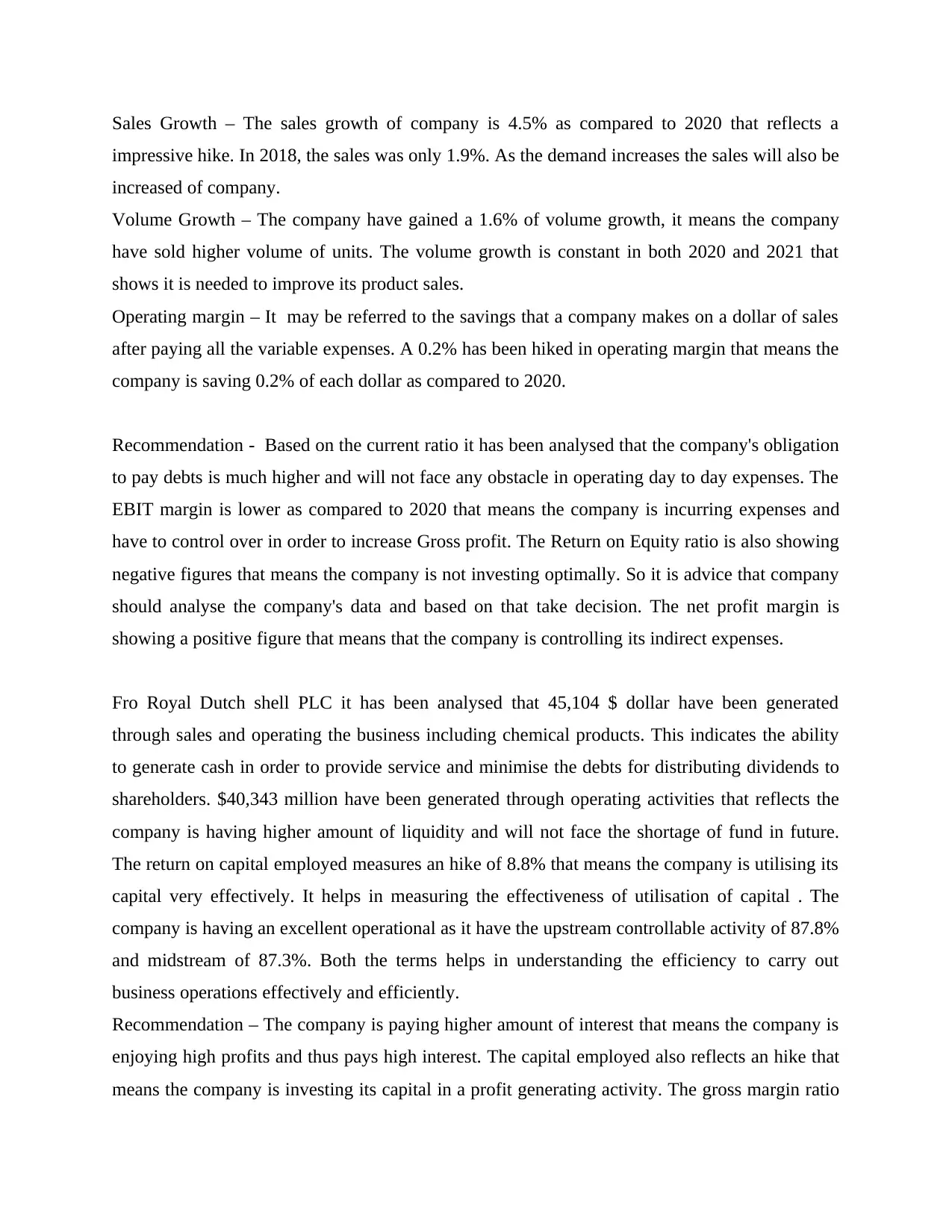
Sales Growth – The sales growth of company is 4.5% as compared to 2020 that reflects a
impressive hike. In 2018, the sales was only 1.9%. As the demand increases the sales will also be
increased of company.
Volume Growth – The company have gained a 1.6% of volume growth, it means the company
have sold higher volume of units. The volume growth is constant in both 2020 and 2021 that
shows it is needed to improve its product sales.
Operating margin – It may be referred to the savings that a company makes on a dollar of sales
after paying all the variable expenses. A 0.2% has been hiked in operating margin that means the
company is saving 0.2% of each dollar as compared to 2020.
Recommendation - Based on the current ratio it has been analysed that the company's obligation
to pay debts is much higher and will not face any obstacle in operating day to day expenses. The
EBIT margin is lower as compared to 2020 that means the company is incurring expenses and
have to control over in order to increase Gross profit. The Return on Equity ratio is also showing
negative figures that means the company is not investing optimally. So it is advice that company
should analyse the company's data and based on that take decision. The net profit margin is
showing a positive figure that means that the company is controlling its indirect expenses.
Fro Royal Dutch shell PLC it has been analysed that 45,104 $ dollar have been generated
through sales and operating the business including chemical products. This indicates the ability
to generate cash in order to provide service and minimise the debts for distributing dividends to
shareholders. $40,343 million have been generated through operating activities that reflects the
company is having higher amount of liquidity and will not face the shortage of fund in future.
The return on capital employed measures an hike of 8.8% that means the company is utilising its
capital very effectively. It helps in measuring the effectiveness of utilisation of capital . The
company is having an excellent operational as it have the upstream controllable activity of 87.8%
and midstream of 87.3%. Both the terms helps in understanding the efficiency to carry out
business operations effectively and efficiently.
Recommendation – The company is paying higher amount of interest that means the company is
enjoying high profits and thus pays high interest. The capital employed also reflects an hike that
means the company is investing its capital in a profit generating activity. The gross margin ratio
impressive hike. In 2018, the sales was only 1.9%. As the demand increases the sales will also be
increased of company.
Volume Growth – The company have gained a 1.6% of volume growth, it means the company
have sold higher volume of units. The volume growth is constant in both 2020 and 2021 that
shows it is needed to improve its product sales.
Operating margin – It may be referred to the savings that a company makes on a dollar of sales
after paying all the variable expenses. A 0.2% has been hiked in operating margin that means the
company is saving 0.2% of each dollar as compared to 2020.
Recommendation - Based on the current ratio it has been analysed that the company's obligation
to pay debts is much higher and will not face any obstacle in operating day to day expenses. The
EBIT margin is lower as compared to 2020 that means the company is incurring expenses and
have to control over in order to increase Gross profit. The Return on Equity ratio is also showing
negative figures that means the company is not investing optimally. So it is advice that company
should analyse the company's data and based on that take decision. The net profit margin is
showing a positive figure that means that the company is controlling its indirect expenses.
Fro Royal Dutch shell PLC it has been analysed that 45,104 $ dollar have been generated
through sales and operating the business including chemical products. This indicates the ability
to generate cash in order to provide service and minimise the debts for distributing dividends to
shareholders. $40,343 million have been generated through operating activities that reflects the
company is having higher amount of liquidity and will not face the shortage of fund in future.
The return on capital employed measures an hike of 8.8% that means the company is utilising its
capital very effectively. It helps in measuring the effectiveness of utilisation of capital . The
company is having an excellent operational as it have the upstream controllable activity of 87.8%
and midstream of 87.3%. Both the terms helps in understanding the efficiency to carry out
business operations effectively and efficiently.
Recommendation – The company is paying higher amount of interest that means the company is
enjoying high profits and thus pays high interest. The capital employed also reflects an hike that
means the company is investing its capital in a profit generating activity. The gross margin ratio
Secure Best Marks with AI Grader
Need help grading? Try our AI Grader for instant feedback on your assignments.
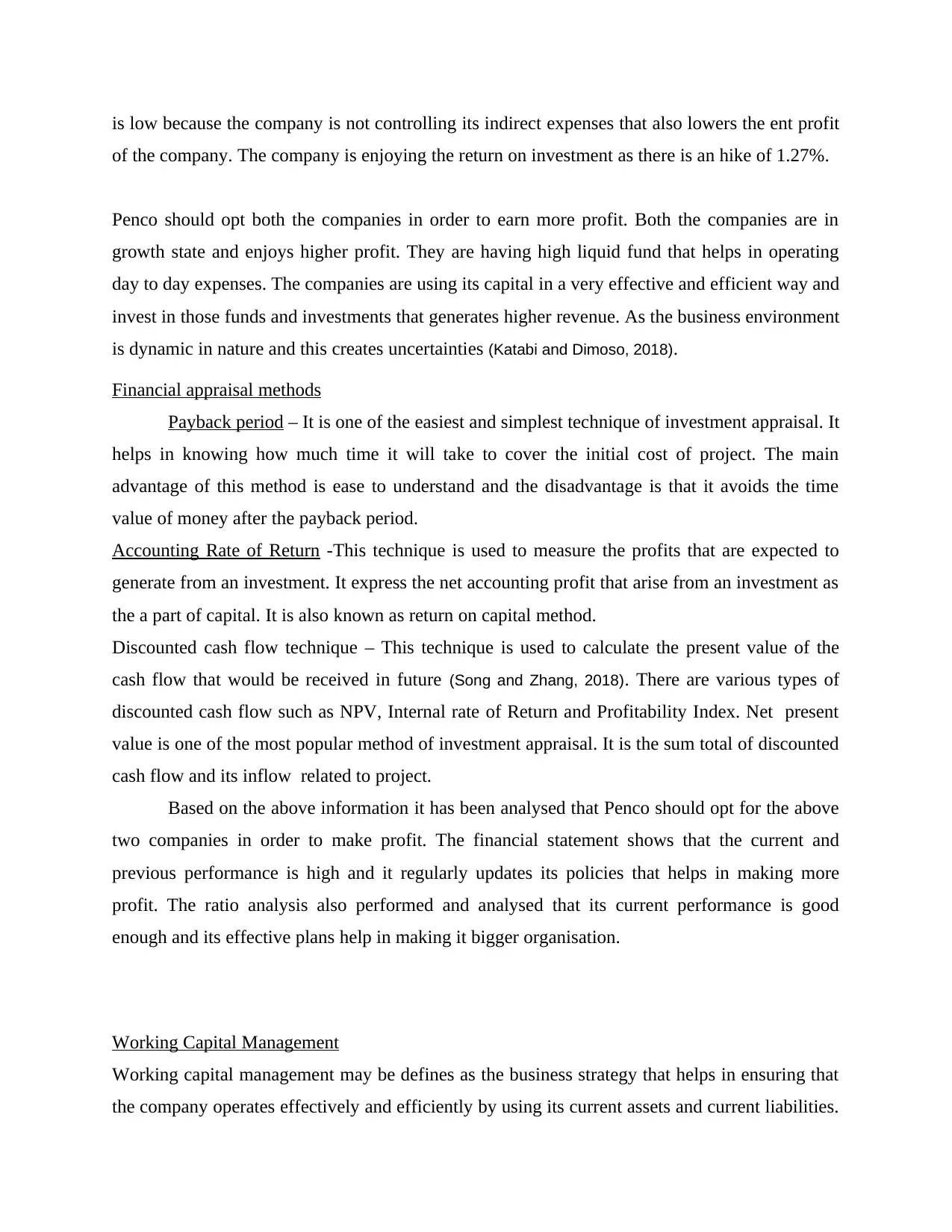
is low because the company is not controlling its indirect expenses that also lowers the ent profit
of the company. The company is enjoying the return on investment as there is an hike of 1.27%.
Penco should opt both the companies in order to earn more profit. Both the companies are in
growth state and enjoys higher profit. They are having high liquid fund that helps in operating
day to day expenses. The companies are using its capital in a very effective and efficient way and
invest in those funds and investments that generates higher revenue. As the business environment
is dynamic in nature and this creates uncertainties (Katabi and Dimoso, 2018).
Financial appraisal methods
Payback period – It is one of the easiest and simplest technique of investment appraisal. It
helps in knowing how much time it will take to cover the initial cost of project. The main
advantage of this method is ease to understand and the disadvantage is that it avoids the time
value of money after the payback period.
Accounting Rate of Return -This technique is used to measure the profits that are expected to
generate from an investment. It express the net accounting profit that arise from an investment as
the a part of capital. It is also known as return on capital method.
Discounted cash flow technique – This technique is used to calculate the present value of the
cash flow that would be received in future (Song and Zhang, 2018). There are various types of
discounted cash flow such as NPV, Internal rate of Return and Profitability Index. Net present
value is one of the most popular method of investment appraisal. It is the sum total of discounted
cash flow and its inflow related to project.
Based on the above information it has been analysed that Penco should opt for the above
two companies in order to make profit. The financial statement shows that the current and
previous performance is high and it regularly updates its policies that helps in making more
profit. The ratio analysis also performed and analysed that its current performance is good
enough and its effective plans help in making it bigger organisation.
Working Capital Management
Working capital management may be defines as the business strategy that helps in ensuring that
the company operates effectively and efficiently by using its current assets and current liabilities.
of the company. The company is enjoying the return on investment as there is an hike of 1.27%.
Penco should opt both the companies in order to earn more profit. Both the companies are in
growth state and enjoys higher profit. They are having high liquid fund that helps in operating
day to day expenses. The companies are using its capital in a very effective and efficient way and
invest in those funds and investments that generates higher revenue. As the business environment
is dynamic in nature and this creates uncertainties (Katabi and Dimoso, 2018).
Financial appraisal methods
Payback period – It is one of the easiest and simplest technique of investment appraisal. It
helps in knowing how much time it will take to cover the initial cost of project. The main
advantage of this method is ease to understand and the disadvantage is that it avoids the time
value of money after the payback period.
Accounting Rate of Return -This technique is used to measure the profits that are expected to
generate from an investment. It express the net accounting profit that arise from an investment as
the a part of capital. It is also known as return on capital method.
Discounted cash flow technique – This technique is used to calculate the present value of the
cash flow that would be received in future (Song and Zhang, 2018). There are various types of
discounted cash flow such as NPV, Internal rate of Return and Profitability Index. Net present
value is one of the most popular method of investment appraisal. It is the sum total of discounted
cash flow and its inflow related to project.
Based on the above information it has been analysed that Penco should opt for the above
two companies in order to make profit. The financial statement shows that the current and
previous performance is high and it regularly updates its policies that helps in making more
profit. The ratio analysis also performed and analysed that its current performance is good
enough and its effective plans help in making it bigger organisation.
Working Capital Management
Working capital management may be defines as the business strategy that helps in ensuring that
the company operates effectively and efficiently by using its current assets and current liabilities.
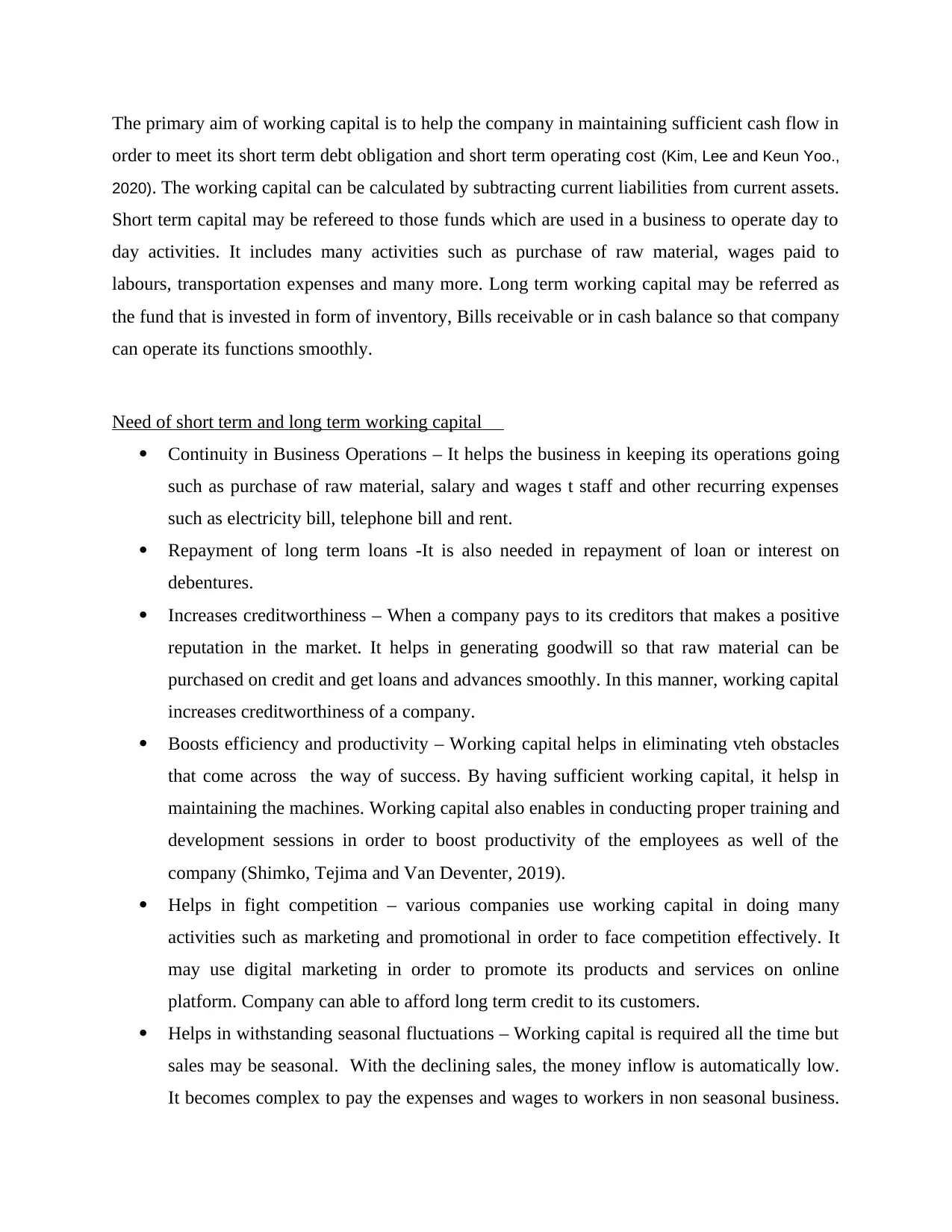
The primary aim of working capital is to help the company in maintaining sufficient cash flow in
order to meet its short term debt obligation and short term operating cost (Kim, Lee and Keun Yoo.,
2020). The working capital can be calculated by subtracting current liabilities from current assets.
Short term capital may be refereed to those funds which are used in a business to operate day to
day activities. It includes many activities such as purchase of raw material, wages paid to
labours, transportation expenses and many more. Long term working capital may be referred as
the fund that is invested in form of inventory, Bills receivable or in cash balance so that company
can operate its functions smoothly.
Need of short term and long term working capital
Continuity in Business Operations – It helps the business in keeping its operations going
such as purchase of raw material, salary and wages t staff and other recurring expenses
such as electricity bill, telephone bill and rent.
Repayment of long term loans -It is also needed in repayment of loan or interest on
debentures.
Increases creditworthiness – When a company pays to its creditors that makes a positive
reputation in the market. It helps in generating goodwill so that raw material can be
purchased on credit and get loans and advances smoothly. In this manner, working capital
increases creditworthiness of a company.
Boosts efficiency and productivity – Working capital helps in eliminating vteh obstacles
that come across the way of success. By having sufficient working capital, it helsp in
maintaining the machines. Working capital also enables in conducting proper training and
development sessions in order to boost productivity of the employees as well of the
company (Shimko, Tejima and Van Deventer, 2019).
Helps in fight competition – various companies use working capital in doing many
activities such as marketing and promotional in order to face competition effectively. It
may use digital marketing in order to promote its products and services on online
platform. Company can able to afford long term credit to its customers.
Helps in withstanding seasonal fluctuations – Working capital is required all the time but
sales may be seasonal. With the declining sales, the money inflow is automatically low.
It becomes complex to pay the expenses and wages to workers in non seasonal business.
order to meet its short term debt obligation and short term operating cost (Kim, Lee and Keun Yoo.,
2020). The working capital can be calculated by subtracting current liabilities from current assets.
Short term capital may be refereed to those funds which are used in a business to operate day to
day activities. It includes many activities such as purchase of raw material, wages paid to
labours, transportation expenses and many more. Long term working capital may be referred as
the fund that is invested in form of inventory, Bills receivable or in cash balance so that company
can operate its functions smoothly.
Need of short term and long term working capital
Continuity in Business Operations – It helps the business in keeping its operations going
such as purchase of raw material, salary and wages t staff and other recurring expenses
such as electricity bill, telephone bill and rent.
Repayment of long term loans -It is also needed in repayment of loan or interest on
debentures.
Increases creditworthiness – When a company pays to its creditors that makes a positive
reputation in the market. It helps in generating goodwill so that raw material can be
purchased on credit and get loans and advances smoothly. In this manner, working capital
increases creditworthiness of a company.
Boosts efficiency and productivity – Working capital helps in eliminating vteh obstacles
that come across the way of success. By having sufficient working capital, it helsp in
maintaining the machines. Working capital also enables in conducting proper training and
development sessions in order to boost productivity of the employees as well of the
company (Shimko, Tejima and Van Deventer, 2019).
Helps in fight competition – various companies use working capital in doing many
activities such as marketing and promotional in order to face competition effectively. It
may use digital marketing in order to promote its products and services on online
platform. Company can able to afford long term credit to its customers.
Helps in withstanding seasonal fluctuations – Working capital is required all the time but
sales may be seasonal. With the declining sales, the money inflow is automatically low.
It becomes complex to pay the expenses and wages to workers in non seasonal business.
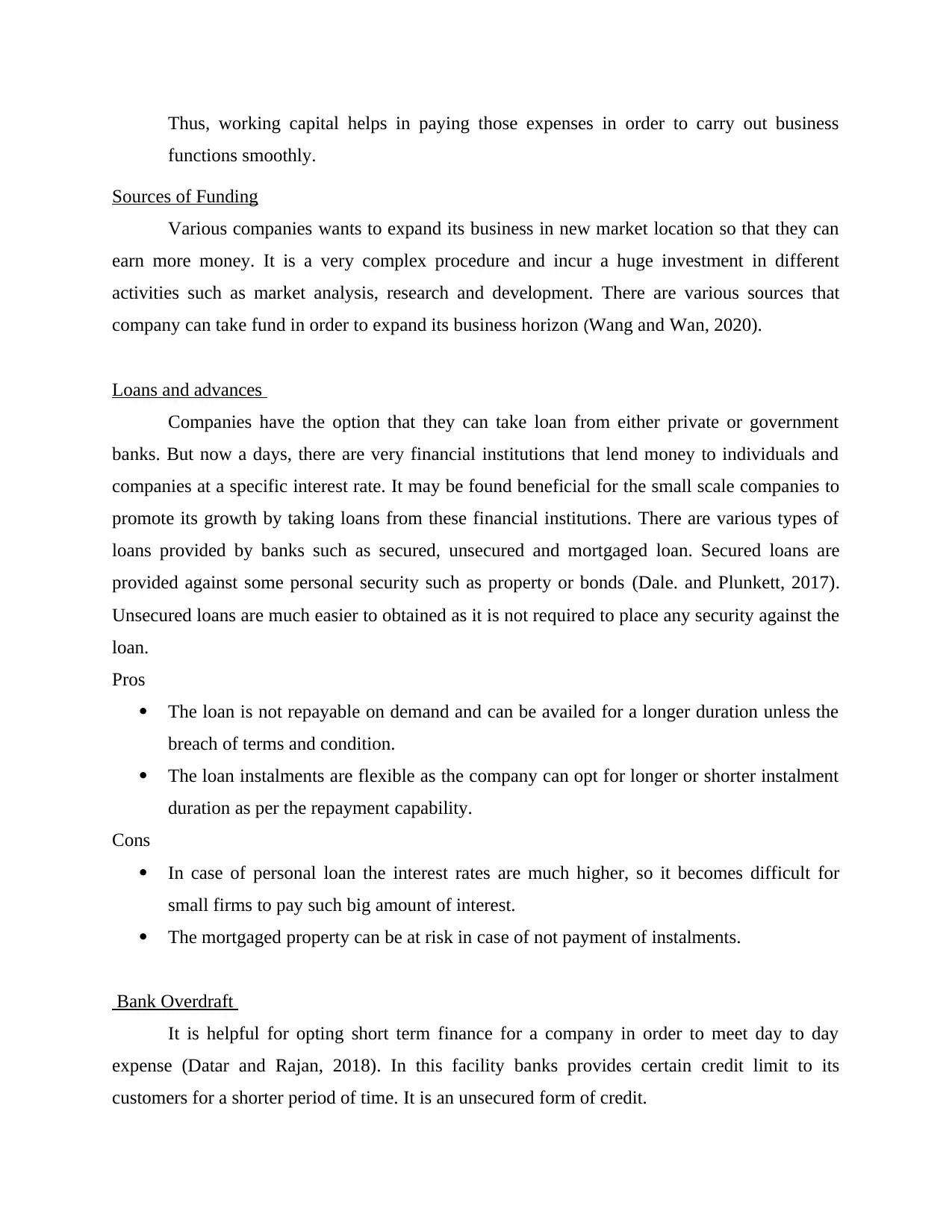
Thus, working capital helps in paying those expenses in order to carry out business
functions smoothly.
Sources of Funding
Various companies wants to expand its business in new market location so that they can
earn more money. It is a very complex procedure and incur a huge investment in different
activities such as market analysis, research and development. There are various sources that
company can take fund in order to expand its business horizon (Wang and Wan, 2020).
Loans and advances
Companies have the option that they can take loan from either private or government
banks. But now a days, there are very financial institutions that lend money to individuals and
companies at a specific interest rate. It may be found beneficial for the small scale companies to
promote its growth by taking loans from these financial institutions. There are various types of
loans provided by banks such as secured, unsecured and mortgaged loan. Secured loans are
provided against some personal security such as property or bonds (Dale. and Plunkett, 2017).
Unsecured loans are much easier to obtained as it is not required to place any security against the
loan.
Pros
The loan is not repayable on demand and can be availed for a longer duration unless the
breach of terms and condition.
The loan instalments are flexible as the company can opt for longer or shorter instalment
duration as per the repayment capability.
Cons
In case of personal loan the interest rates are much higher, so it becomes difficult for
small firms to pay such big amount of interest.
The mortgaged property can be at risk in case of not payment of instalments.
Bank Overdraft
It is helpful for opting short term finance for a company in order to meet day to day
expense (Datar and Rajan, 2018). In this facility banks provides certain credit limit to its
customers for a shorter period of time. It is an unsecured form of credit.
functions smoothly.
Sources of Funding
Various companies wants to expand its business in new market location so that they can
earn more money. It is a very complex procedure and incur a huge investment in different
activities such as market analysis, research and development. There are various sources that
company can take fund in order to expand its business horizon (Wang and Wan, 2020).
Loans and advances
Companies have the option that they can take loan from either private or government
banks. But now a days, there are very financial institutions that lend money to individuals and
companies at a specific interest rate. It may be found beneficial for the small scale companies to
promote its growth by taking loans from these financial institutions. There are various types of
loans provided by banks such as secured, unsecured and mortgaged loan. Secured loans are
provided against some personal security such as property or bonds (Dale. and Plunkett, 2017).
Unsecured loans are much easier to obtained as it is not required to place any security against the
loan.
Pros
The loan is not repayable on demand and can be availed for a longer duration unless the
breach of terms and condition.
The loan instalments are flexible as the company can opt for longer or shorter instalment
duration as per the repayment capability.
Cons
In case of personal loan the interest rates are much higher, so it becomes difficult for
small firms to pay such big amount of interest.
The mortgaged property can be at risk in case of not payment of instalments.
Bank Overdraft
It is helpful for opting short term finance for a company in order to meet day to day
expense (Datar and Rajan, 2018). In this facility banks provides certain credit limit to its
customers for a shorter period of time. It is an unsecured form of credit.
Paraphrase This Document
Need a fresh take? Get an instant paraphrase of this document with our AI Paraphraser
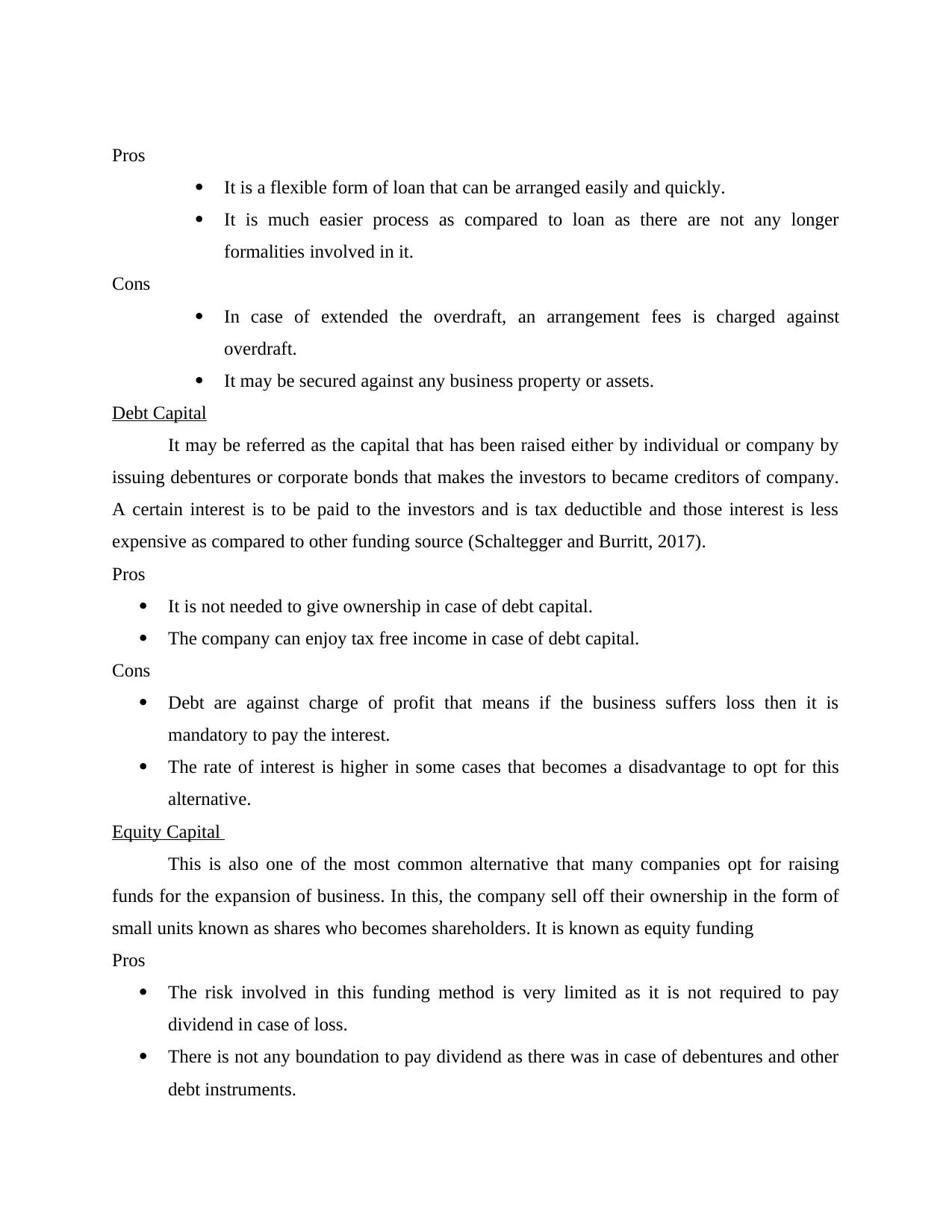
Pros
It is a flexible form of loan that can be arranged easily and quickly.
It is much easier process as compared to loan as there are not any longer
formalities involved in it.
Cons
In case of extended the overdraft, an arrangement fees is charged against
overdraft.
It may be secured against any business property or assets.
Debt Capital
It may be referred as the capital that has been raised either by individual or company by
issuing debentures or corporate bonds that makes the investors to became creditors of company.
A certain interest is to be paid to the investors and is tax deductible and those interest is less
expensive as compared to other funding source (Schaltegger and Burritt, 2017).
Pros
It is not needed to give ownership in case of debt capital.
The company can enjoy tax free income in case of debt capital.
Cons
Debt are against charge of profit that means if the business suffers loss then it is
mandatory to pay the interest.
The rate of interest is higher in some cases that becomes a disadvantage to opt for this
alternative.
Equity Capital
This is also one of the most common alternative that many companies opt for raising
funds for the expansion of business. In this, the company sell off their ownership in the form of
small units known as shares who becomes shareholders. It is known as equity funding
Pros
The risk involved in this funding method is very limited as it is not required to pay
dividend in case of loss.
There is not any boundation to pay dividend as there was in case of debentures and other
debt instruments.
It is a flexible form of loan that can be arranged easily and quickly.
It is much easier process as compared to loan as there are not any longer
formalities involved in it.
Cons
In case of extended the overdraft, an arrangement fees is charged against
overdraft.
It may be secured against any business property or assets.
Debt Capital
It may be referred as the capital that has been raised either by individual or company by
issuing debentures or corporate bonds that makes the investors to became creditors of company.
A certain interest is to be paid to the investors and is tax deductible and those interest is less
expensive as compared to other funding source (Schaltegger and Burritt, 2017).
Pros
It is not needed to give ownership in case of debt capital.
The company can enjoy tax free income in case of debt capital.
Cons
Debt are against charge of profit that means if the business suffers loss then it is
mandatory to pay the interest.
The rate of interest is higher in some cases that becomes a disadvantage to opt for this
alternative.
Equity Capital
This is also one of the most common alternative that many companies opt for raising
funds for the expansion of business. In this, the company sell off their ownership in the form of
small units known as shares who becomes shareholders. It is known as equity funding
Pros
The risk involved in this funding method is very limited as it is not required to pay
dividend in case of loss.
There is not any boundation to pay dividend as there was in case of debentures and other
debt instruments.
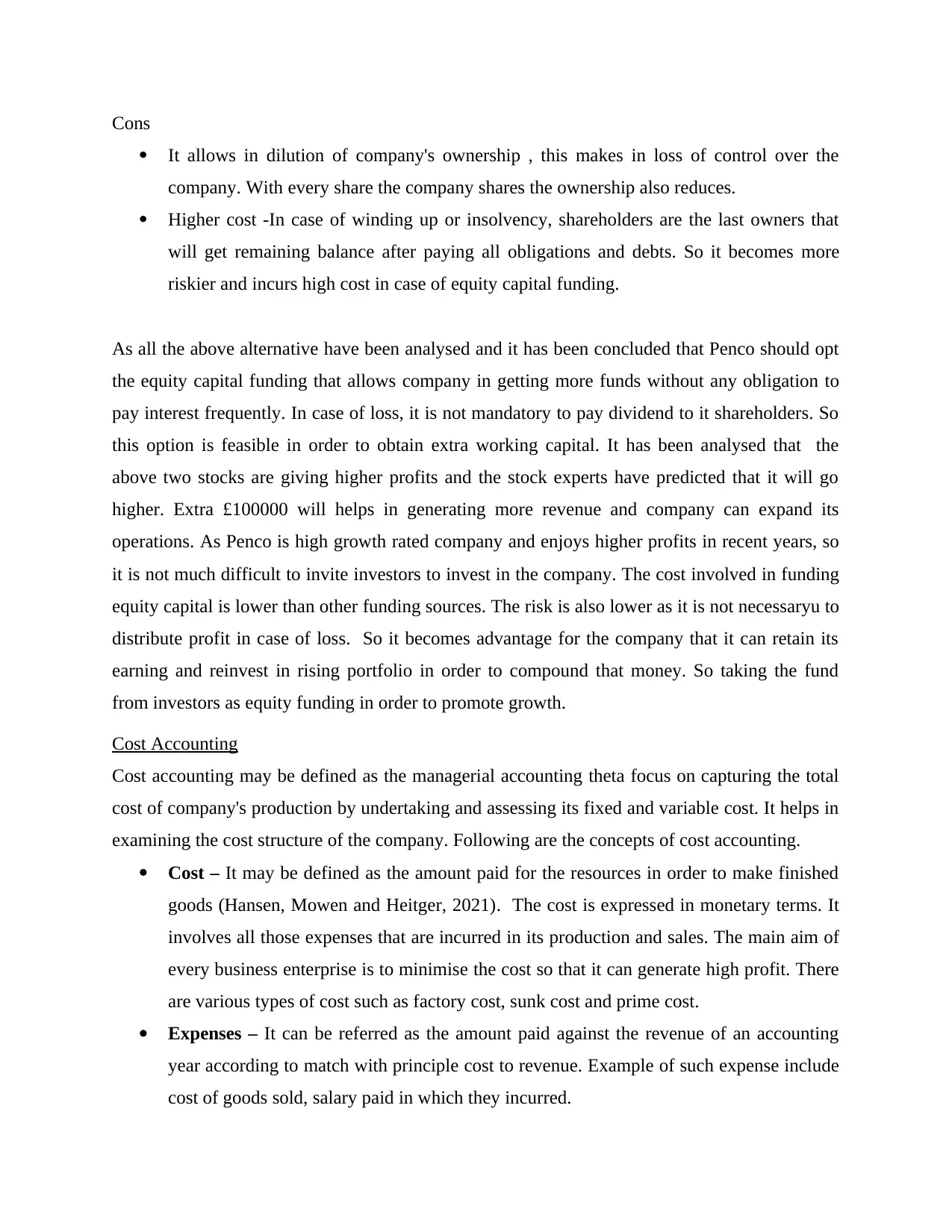
Cons
It allows in dilution of company's ownership , this makes in loss of control over the
company. With every share the company shares the ownership also reduces.
Higher cost -In case of winding up or insolvency, shareholders are the last owners that
will get remaining balance after paying all obligations and debts. So it becomes more
riskier and incurs high cost in case of equity capital funding.
As all the above alternative have been analysed and it has been concluded that Penco should opt
the equity capital funding that allows company in getting more funds without any obligation to
pay interest frequently. In case of loss, it is not mandatory to pay dividend to it shareholders. So
this option is feasible in order to obtain extra working capital. It has been analysed that the
above two stocks are giving higher profits and the stock experts have predicted that it will go
higher. Extra £100000 will helps in generating more revenue and company can expand its
operations. As Penco is high growth rated company and enjoys higher profits in recent years, so
it is not much difficult to invite investors to invest in the company. The cost involved in funding
equity capital is lower than other funding sources. The risk is also lower as it is not necessaryu to
distribute profit in case of loss. So it becomes advantage for the company that it can retain its
earning and reinvest in rising portfolio in order to compound that money. So taking the fund
from investors as equity funding in order to promote growth.
Cost Accounting
Cost accounting may be defined as the managerial accounting theta focus on capturing the total
cost of company's production by undertaking and assessing its fixed and variable cost. It helps in
examining the cost structure of the company. Following are the concepts of cost accounting.
Cost – It may be defined as the amount paid for the resources in order to make finished
goods (Hansen, Mowen and Heitger, 2021). The cost is expressed in monetary terms. It
involves all those expenses that are incurred in its production and sales. The main aim of
every business enterprise is to minimise the cost so that it can generate high profit. There
are various types of cost such as factory cost, sunk cost and prime cost.
Expenses – It can be referred as the amount paid against the revenue of an accounting
year according to match with principle cost to revenue. Example of such expense include
cost of goods sold, salary paid in which they incurred.
It allows in dilution of company's ownership , this makes in loss of control over the
company. With every share the company shares the ownership also reduces.
Higher cost -In case of winding up or insolvency, shareholders are the last owners that
will get remaining balance after paying all obligations and debts. So it becomes more
riskier and incurs high cost in case of equity capital funding.
As all the above alternative have been analysed and it has been concluded that Penco should opt
the equity capital funding that allows company in getting more funds without any obligation to
pay interest frequently. In case of loss, it is not mandatory to pay dividend to it shareholders. So
this option is feasible in order to obtain extra working capital. It has been analysed that the
above two stocks are giving higher profits and the stock experts have predicted that it will go
higher. Extra £100000 will helps in generating more revenue and company can expand its
operations. As Penco is high growth rated company and enjoys higher profits in recent years, so
it is not much difficult to invite investors to invest in the company. The cost involved in funding
equity capital is lower than other funding sources. The risk is also lower as it is not necessaryu to
distribute profit in case of loss. So it becomes advantage for the company that it can retain its
earning and reinvest in rising portfolio in order to compound that money. So taking the fund
from investors as equity funding in order to promote growth.
Cost Accounting
Cost accounting may be defined as the managerial accounting theta focus on capturing the total
cost of company's production by undertaking and assessing its fixed and variable cost. It helps in
examining the cost structure of the company. Following are the concepts of cost accounting.
Cost – It may be defined as the amount paid for the resources in order to make finished
goods (Hansen, Mowen and Heitger, 2021). The cost is expressed in monetary terms. It
involves all those expenses that are incurred in its production and sales. The main aim of
every business enterprise is to minimise the cost so that it can generate high profit. There
are various types of cost such as factory cost, sunk cost and prime cost.
Expenses – It can be referred as the amount paid against the revenue of an accounting
year according to match with principle cost to revenue. Example of such expense include
cost of goods sold, salary paid in which they incurred.
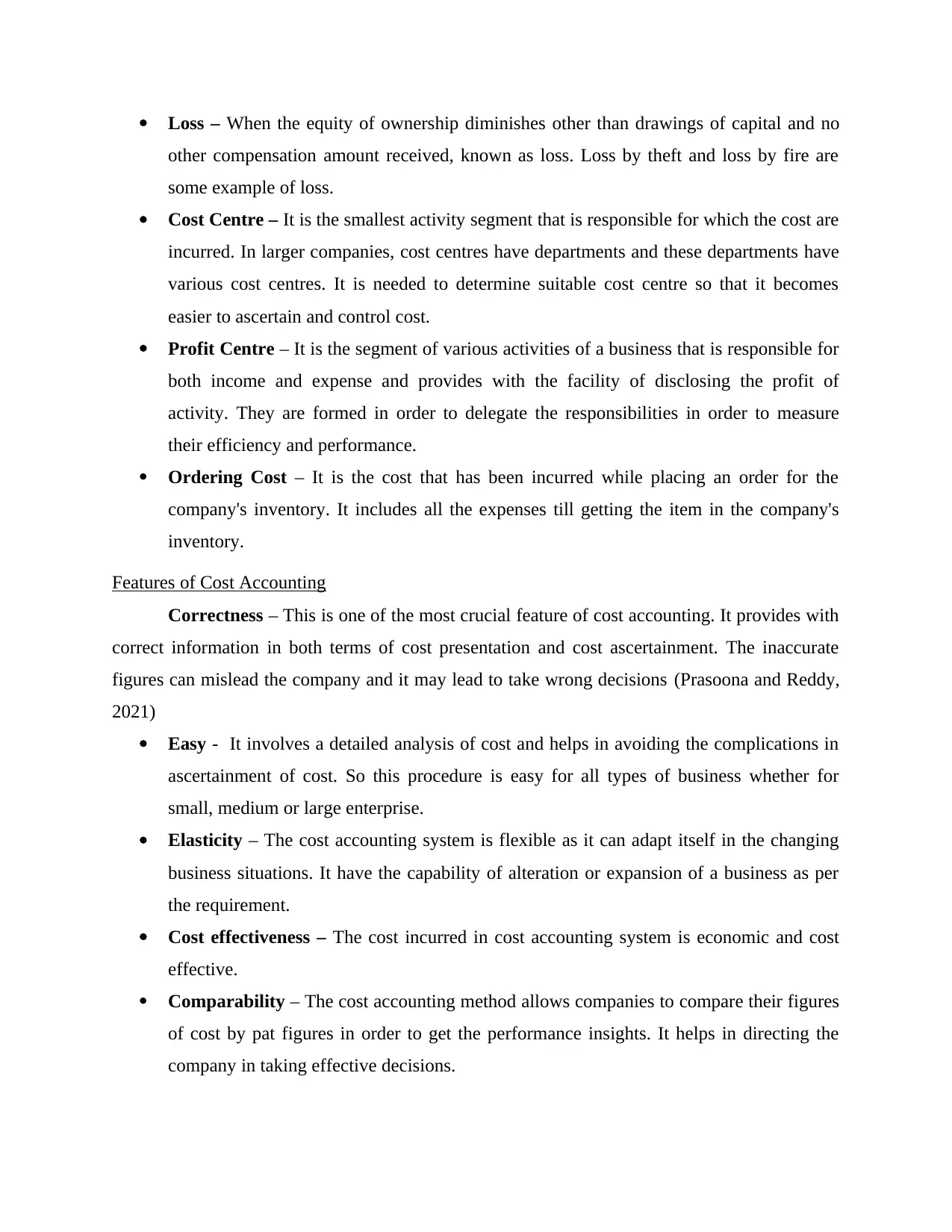
Loss – When the equity of ownership diminishes other than drawings of capital and no
other compensation amount received, known as loss. Loss by theft and loss by fire are
some example of loss.
Cost Centre – It is the smallest activity segment that is responsible for which the cost are
incurred. In larger companies, cost centres have departments and these departments have
various cost centres. It is needed to determine suitable cost centre so that it becomes
easier to ascertain and control cost.
Profit Centre – It is the segment of various activities of a business that is responsible for
both income and expense and provides with the facility of disclosing the profit of
activity. They are formed in order to delegate the responsibilities in order to measure
their efficiency and performance.
Ordering Cost – It is the cost that has been incurred while placing an order for the
company's inventory. It includes all the expenses till getting the item in the company's
inventory.
Features of Cost Accounting
Correctness – This is one of the most crucial feature of cost accounting. It provides with
correct information in both terms of cost presentation and cost ascertainment. The inaccurate
figures can mislead the company and it may lead to take wrong decisions (Prasoona and Reddy,
2021)
Easy - It involves a detailed analysis of cost and helps in avoiding the complications in
ascertainment of cost. So this procedure is easy for all types of business whether for
small, medium or large enterprise.
Elasticity – The cost accounting system is flexible as it can adapt itself in the changing
business situations. It have the capability of alteration or expansion of a business as per
the requirement.
Cost effectiveness – The cost incurred in cost accounting system is economic and cost
effective.
Comparability – The cost accounting method allows companies to compare their figures
of cost by pat figures in order to get the performance insights. It helps in directing the
company in taking effective decisions.
other compensation amount received, known as loss. Loss by theft and loss by fire are
some example of loss.
Cost Centre – It is the smallest activity segment that is responsible for which the cost are
incurred. In larger companies, cost centres have departments and these departments have
various cost centres. It is needed to determine suitable cost centre so that it becomes
easier to ascertain and control cost.
Profit Centre – It is the segment of various activities of a business that is responsible for
both income and expense and provides with the facility of disclosing the profit of
activity. They are formed in order to delegate the responsibilities in order to measure
their efficiency and performance.
Ordering Cost – It is the cost that has been incurred while placing an order for the
company's inventory. It includes all the expenses till getting the item in the company's
inventory.
Features of Cost Accounting
Correctness – This is one of the most crucial feature of cost accounting. It provides with
correct information in both terms of cost presentation and cost ascertainment. The inaccurate
figures can mislead the company and it may lead to take wrong decisions (Prasoona and Reddy,
2021)
Easy - It involves a detailed analysis of cost and helps in avoiding the complications in
ascertainment of cost. So this procedure is easy for all types of business whether for
small, medium or large enterprise.
Elasticity – The cost accounting system is flexible as it can adapt itself in the changing
business situations. It have the capability of alteration or expansion of a business as per
the requirement.
Cost effectiveness – The cost incurred in cost accounting system is economic and cost
effective.
Comparability – The cost accounting method allows companies to compare their figures
of cost by pat figures in order to get the performance insights. It helps in directing the
company in taking effective decisions.
Secure Best Marks with AI Grader
Need help grading? Try our AI Grader for instant feedback on your assignments.
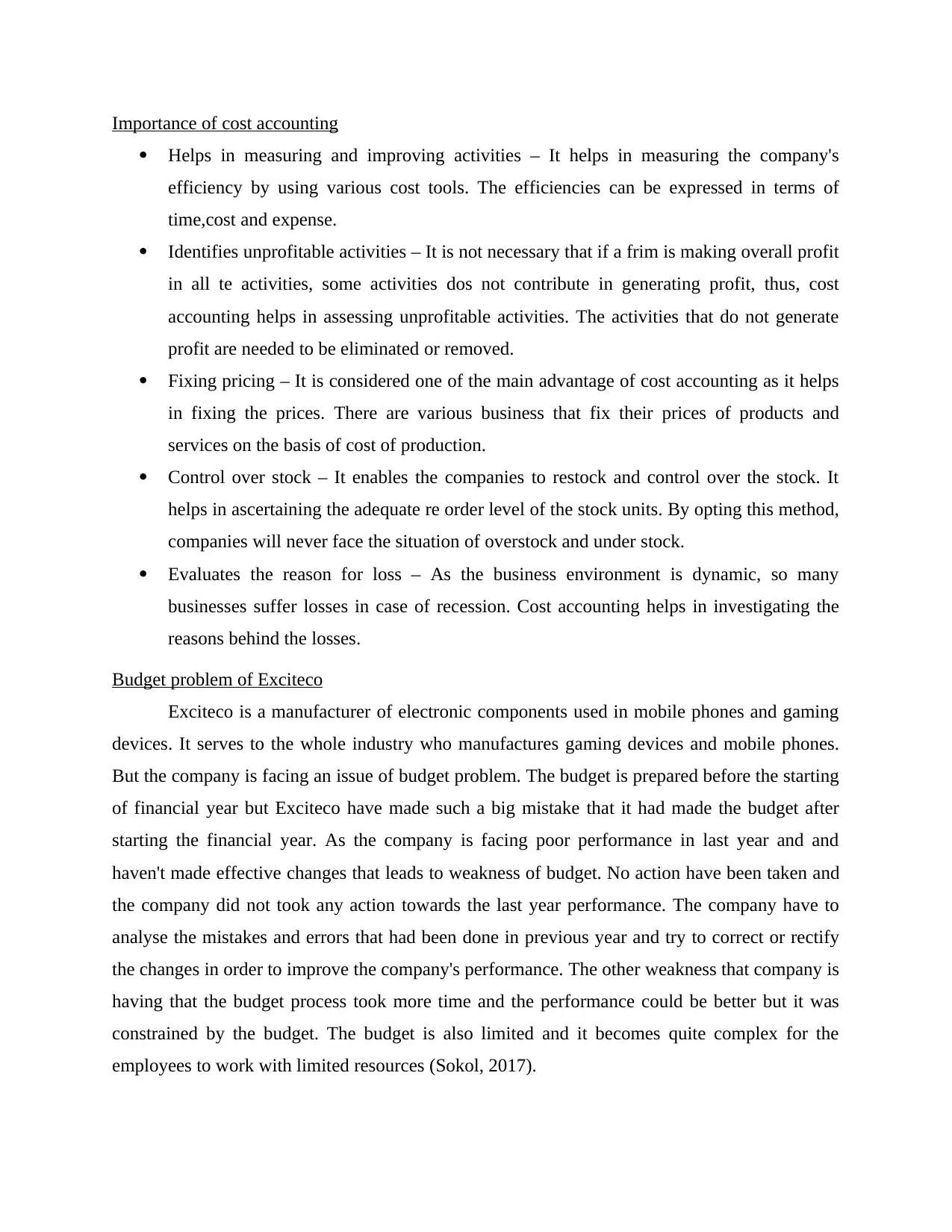
Importance of cost accounting
Helps in measuring and improving activities – It helps in measuring the company's
efficiency by using various cost tools. The efficiencies can be expressed in terms of
time,cost and expense.
Identifies unprofitable activities – It is not necessary that if a frim is making overall profit
in all te activities, some activities dos not contribute in generating profit, thus, cost
accounting helps in assessing unprofitable activities. The activities that do not generate
profit are needed to be eliminated or removed.
Fixing pricing – It is considered one of the main advantage of cost accounting as it helps
in fixing the prices. There are various business that fix their prices of products and
services on the basis of cost of production.
Control over stock – It enables the companies to restock and control over the stock. It
helps in ascertaining the adequate re order level of the stock units. By opting this method,
companies will never face the situation of overstock and under stock.
Evaluates the reason for loss – As the business environment is dynamic, so many
businesses suffer losses in case of recession. Cost accounting helps in investigating the
reasons behind the losses.
Budget problem of Exciteco
Exciteco is a manufacturer of electronic components used in mobile phones and gaming
devices. It serves to the whole industry who manufactures gaming devices and mobile phones.
But the company is facing an issue of budget problem. The budget is prepared before the starting
of financial year but Exciteco have made such a big mistake that it had made the budget after
starting the financial year. As the company is facing poor performance in last year and and
haven't made effective changes that leads to weakness of budget. No action have been taken and
the company did not took any action towards the last year performance. The company have to
analyse the mistakes and errors that had been done in previous year and try to correct or rectify
the changes in order to improve the company's performance. The other weakness that company is
having that the budget process took more time and the performance could be better but it was
constrained by the budget. The budget is also limited and it becomes quite complex for the
employees to work with limited resources (Sokol, 2017).
Helps in measuring and improving activities – It helps in measuring the company's
efficiency by using various cost tools. The efficiencies can be expressed in terms of
time,cost and expense.
Identifies unprofitable activities – It is not necessary that if a frim is making overall profit
in all te activities, some activities dos not contribute in generating profit, thus, cost
accounting helps in assessing unprofitable activities. The activities that do not generate
profit are needed to be eliminated or removed.
Fixing pricing – It is considered one of the main advantage of cost accounting as it helps
in fixing the prices. There are various business that fix their prices of products and
services on the basis of cost of production.
Control over stock – It enables the companies to restock and control over the stock. It
helps in ascertaining the adequate re order level of the stock units. By opting this method,
companies will never face the situation of overstock and under stock.
Evaluates the reason for loss – As the business environment is dynamic, so many
businesses suffer losses in case of recession. Cost accounting helps in investigating the
reasons behind the losses.
Budget problem of Exciteco
Exciteco is a manufacturer of electronic components used in mobile phones and gaming
devices. It serves to the whole industry who manufactures gaming devices and mobile phones.
But the company is facing an issue of budget problem. The budget is prepared before the starting
of financial year but Exciteco have made such a big mistake that it had made the budget after
starting the financial year. As the company is facing poor performance in last year and and
haven't made effective changes that leads to weakness of budget. No action have been taken and
the company did not took any action towards the last year performance. The company have to
analyse the mistakes and errors that had been done in previous year and try to correct or rectify
the changes in order to improve the company's performance. The other weakness that company is
having that the budget process took more time and the performance could be better but it was
constrained by the budget. The budget is also limited and it becomes quite complex for the
employees to work with limited resources (Sokol, 2017).
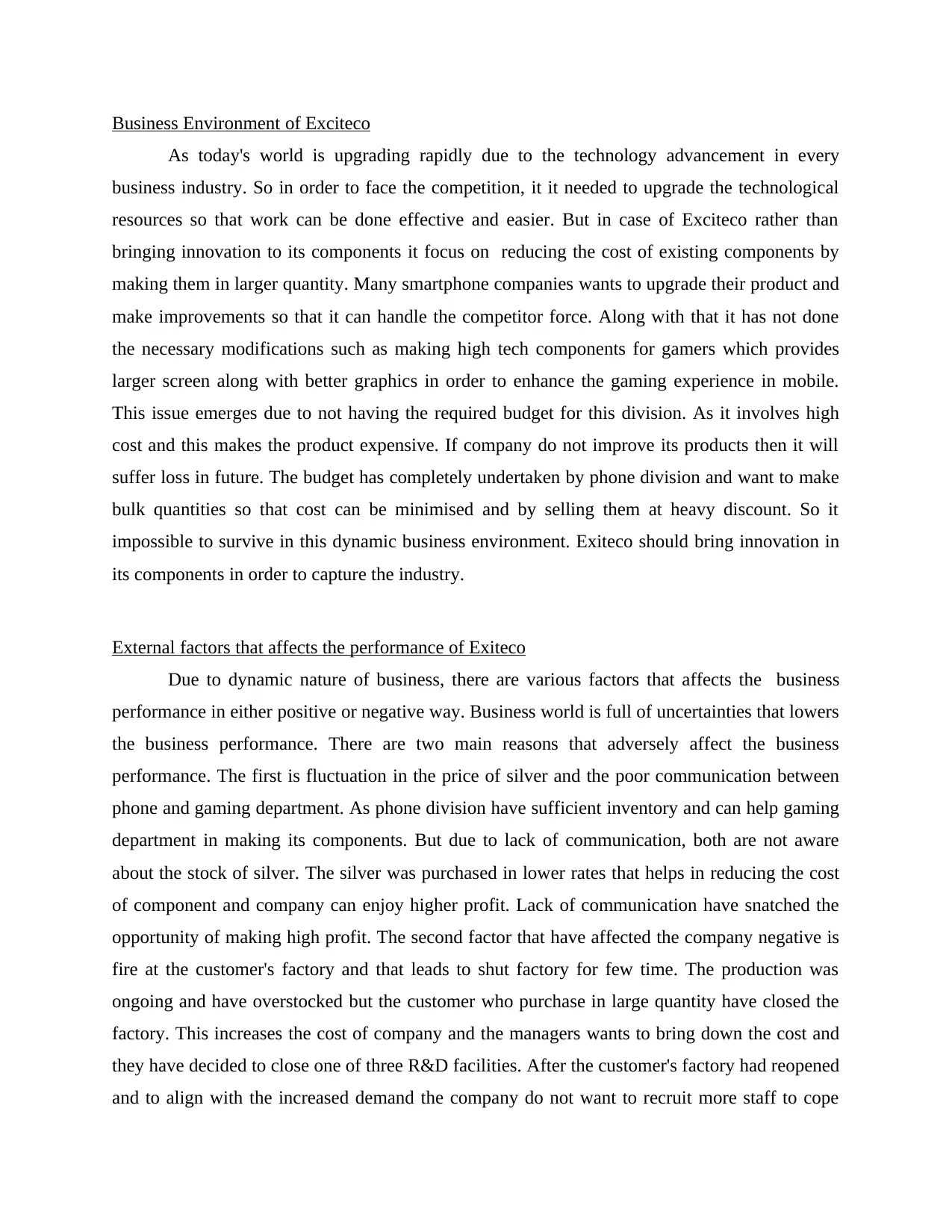
Business Environment of Exciteco
As today's world is upgrading rapidly due to the technology advancement in every
business industry. So in order to face the competition, it it needed to upgrade the technological
resources so that work can be done effective and easier. But in case of Exciteco rather than
bringing innovation to its components it focus on reducing the cost of existing components by
making them in larger quantity. Many smartphone companies wants to upgrade their product and
make improvements so that it can handle the competitor force. Along with that it has not done
the necessary modifications such as making high tech components for gamers which provides
larger screen along with better graphics in order to enhance the gaming experience in mobile.
This issue emerges due to not having the required budget for this division. As it involves high
cost and this makes the product expensive. If company do not improve its products then it will
suffer loss in future. The budget has completely undertaken by phone division and want to make
bulk quantities so that cost can be minimised and by selling them at heavy discount. So it
impossible to survive in this dynamic business environment. Exiteco should bring innovation in
its components in order to capture the industry.
External factors that affects the performance of Exiteco
Due to dynamic nature of business, there are various factors that affects the business
performance in either positive or negative way. Business world is full of uncertainties that lowers
the business performance. There are two main reasons that adversely affect the business
performance. The first is fluctuation in the price of silver and the poor communication between
phone and gaming department. As phone division have sufficient inventory and can help gaming
department in making its components. But due to lack of communication, both are not aware
about the stock of silver. The silver was purchased in lower rates that helps in reducing the cost
of component and company can enjoy higher profit. Lack of communication have snatched the
opportunity of making high profit. The second factor that have affected the company negative is
fire at the customer's factory and that leads to shut factory for few time. The production was
ongoing and have overstocked but the customer who purchase in large quantity have closed the
factory. This increases the cost of company and the managers wants to bring down the cost and
they have decided to close one of three R&D facilities. After the customer's factory had reopened
and to align with the increased demand the company do not want to recruit more staff to cope
As today's world is upgrading rapidly due to the technology advancement in every
business industry. So in order to face the competition, it it needed to upgrade the technological
resources so that work can be done effective and easier. But in case of Exciteco rather than
bringing innovation to its components it focus on reducing the cost of existing components by
making them in larger quantity. Many smartphone companies wants to upgrade their product and
make improvements so that it can handle the competitor force. Along with that it has not done
the necessary modifications such as making high tech components for gamers which provides
larger screen along with better graphics in order to enhance the gaming experience in mobile.
This issue emerges due to not having the required budget for this division. As it involves high
cost and this makes the product expensive. If company do not improve its products then it will
suffer loss in future. The budget has completely undertaken by phone division and want to make
bulk quantities so that cost can be minimised and by selling them at heavy discount. So it
impossible to survive in this dynamic business environment. Exiteco should bring innovation in
its components in order to capture the industry.
External factors that affects the performance of Exiteco
Due to dynamic nature of business, there are various factors that affects the business
performance in either positive or negative way. Business world is full of uncertainties that lowers
the business performance. There are two main reasons that adversely affect the business
performance. The first is fluctuation in the price of silver and the poor communication between
phone and gaming department. As phone division have sufficient inventory and can help gaming
department in making its components. But due to lack of communication, both are not aware
about the stock of silver. The silver was purchased in lower rates that helps in reducing the cost
of component and company can enjoy higher profit. Lack of communication have snatched the
opportunity of making high profit. The second factor that have affected the company negative is
fire at the customer's factory and that leads to shut factory for few time. The production was
ongoing and have overstocked but the customer who purchase in large quantity have closed the
factory. This increases the cost of company and the managers wants to bring down the cost and
they have decided to close one of three R&D facilities. After the customer's factory had reopened
and to align with the increased demand the company do not want to recruit more staff to cope
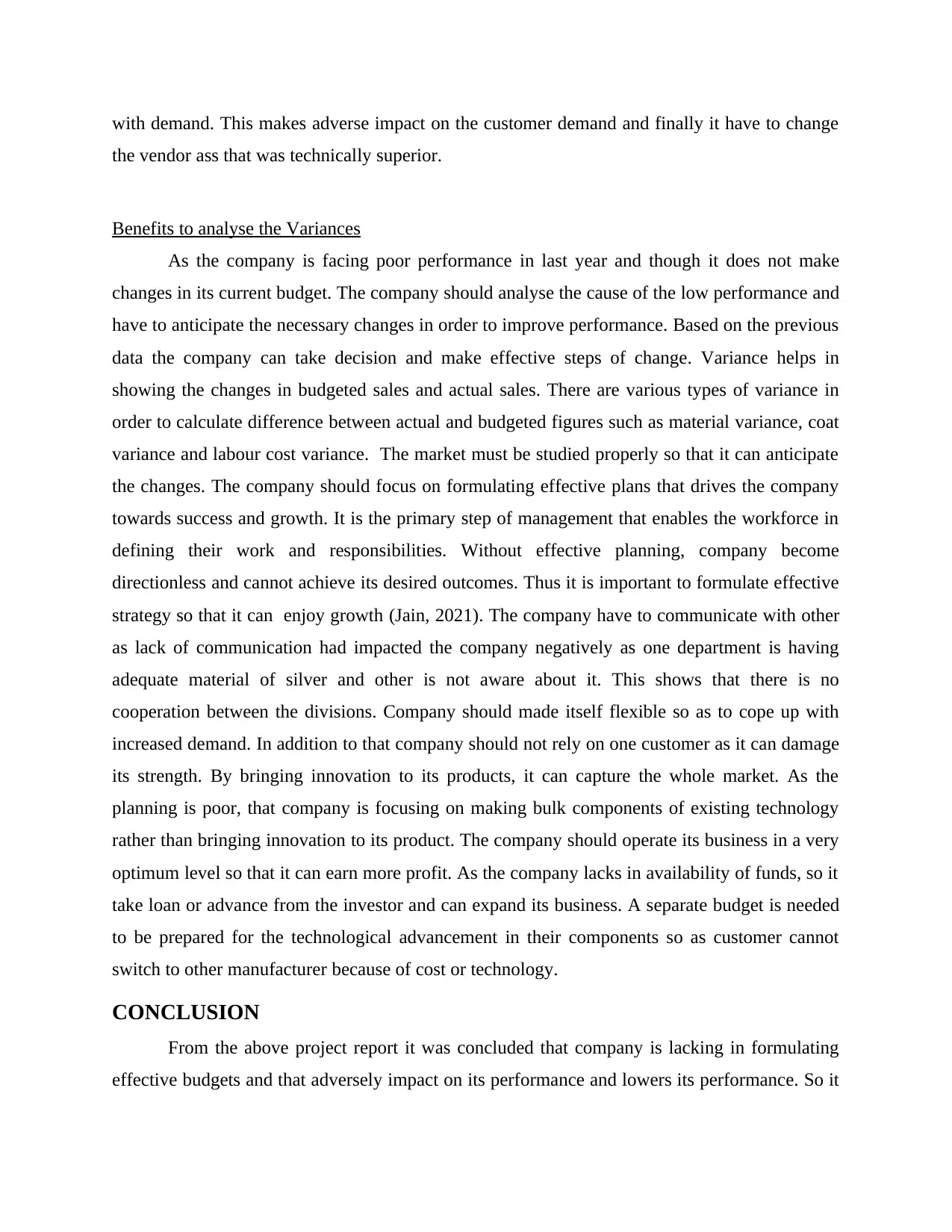
with demand. This makes adverse impact on the customer demand and finally it have to change
the vendor ass that was technically superior.
Benefits to analyse the Variances
As the company is facing poor performance in last year and though it does not make
changes in its current budget. The company should analyse the cause of the low performance and
have to anticipate the necessary changes in order to improve performance. Based on the previous
data the company can take decision and make effective steps of change. Variance helps in
showing the changes in budgeted sales and actual sales. There are various types of variance in
order to calculate difference between actual and budgeted figures such as material variance, coat
variance and labour cost variance. The market must be studied properly so that it can anticipate
the changes. The company should focus on formulating effective plans that drives the company
towards success and growth. It is the primary step of management that enables the workforce in
defining their work and responsibilities. Without effective planning, company become
directionless and cannot achieve its desired outcomes. Thus it is important to formulate effective
strategy so that it can enjoy growth (Jain, 2021). The company have to communicate with other
as lack of communication had impacted the company negatively as one department is having
adequate material of silver and other is not aware about it. This shows that there is no
cooperation between the divisions. Company should made itself flexible so as to cope up with
increased demand. In addition to that company should not rely on one customer as it can damage
its strength. By bringing innovation to its products, it can capture the whole market. As the
planning is poor, that company is focusing on making bulk components of existing technology
rather than bringing innovation to its product. The company should operate its business in a very
optimum level so that it can earn more profit. As the company lacks in availability of funds, so it
take loan or advance from the investor and can expand its business. A separate budget is needed
to be prepared for the technological advancement in their components so as customer cannot
switch to other manufacturer because of cost or technology.
CONCLUSION
From the above project report it was concluded that company is lacking in formulating
effective budgets and that adversely impact on its performance and lowers its performance. So it
the vendor ass that was technically superior.
Benefits to analyse the Variances
As the company is facing poor performance in last year and though it does not make
changes in its current budget. The company should analyse the cause of the low performance and
have to anticipate the necessary changes in order to improve performance. Based on the previous
data the company can take decision and make effective steps of change. Variance helps in
showing the changes in budgeted sales and actual sales. There are various types of variance in
order to calculate difference between actual and budgeted figures such as material variance, coat
variance and labour cost variance. The market must be studied properly so that it can anticipate
the changes. The company should focus on formulating effective plans that drives the company
towards success and growth. It is the primary step of management that enables the workforce in
defining their work and responsibilities. Without effective planning, company become
directionless and cannot achieve its desired outcomes. Thus it is important to formulate effective
strategy so that it can enjoy growth (Jain, 2021). The company have to communicate with other
as lack of communication had impacted the company negatively as one department is having
adequate material of silver and other is not aware about it. This shows that there is no
cooperation between the divisions. Company should made itself flexible so as to cope up with
increased demand. In addition to that company should not rely on one customer as it can damage
its strength. By bringing innovation to its products, it can capture the whole market. As the
planning is poor, that company is focusing on making bulk components of existing technology
rather than bringing innovation to its product. The company should operate its business in a very
optimum level so that it can earn more profit. As the company lacks in availability of funds, so it
take loan or advance from the investor and can expand its business. A separate budget is needed
to be prepared for the technological advancement in their components so as customer cannot
switch to other manufacturer because of cost or technology.
CONCLUSION
From the above project report it was concluded that company is lacking in formulating
effective budgets and that adversely impact on its performance and lowers its performance. So it
Paraphrase This Document
Need a fresh take? Get an instant paraphrase of this document with our AI Paraphraser
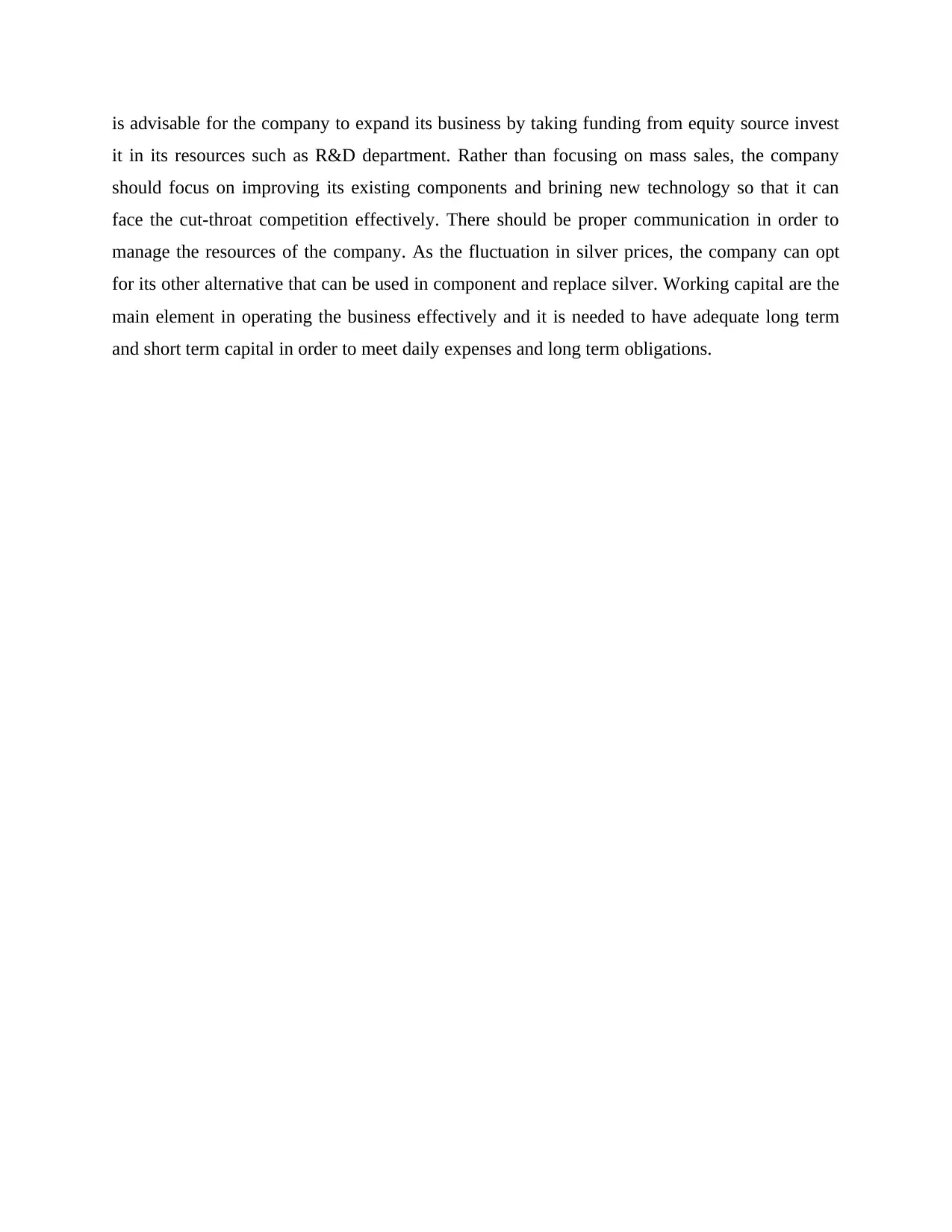
is advisable for the company to expand its business by taking funding from equity source invest
it in its resources such as R&D department. Rather than focusing on mass sales, the company
should focus on improving its existing components and brining new technology so that it can
face the cut-throat competition effectively. There should be proper communication in order to
manage the resources of the company. As the fluctuation in silver prices, the company can opt
for its other alternative that can be used in component and replace silver. Working capital are the
main element in operating the business effectively and it is needed to have adequate long term
and short term capital in order to meet daily expenses and long term obligations.
it in its resources such as R&D department. Rather than focusing on mass sales, the company
should focus on improving its existing components and brining new technology so that it can
face the cut-throat competition effectively. There should be proper communication in order to
manage the resources of the company. As the fluctuation in silver prices, the company can opt
for its other alternative that can be used in component and replace silver. Working capital are the
main element in operating the business effectively and it is needed to have adequate long term
and short term capital in order to meet daily expenses and long term obligations.
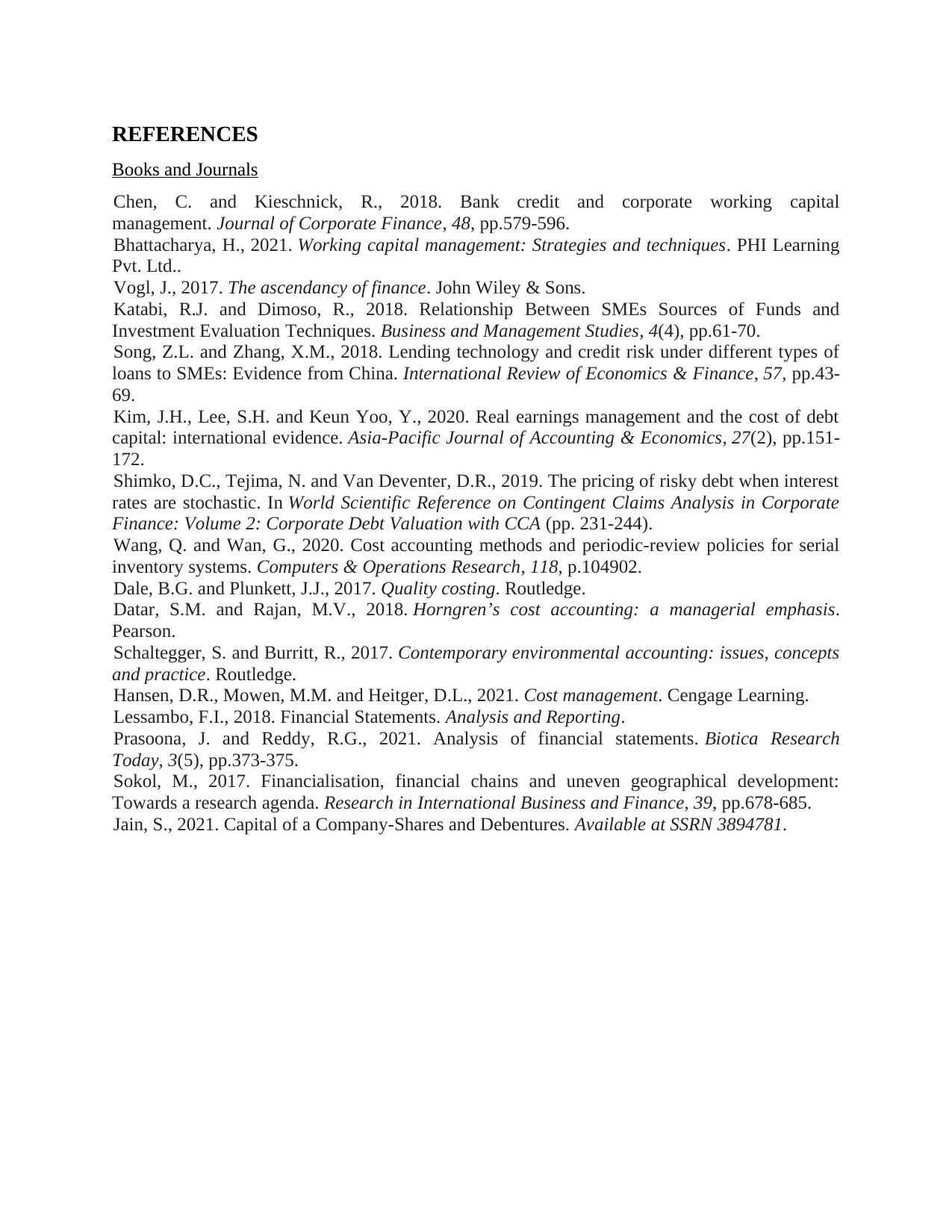
REFERENCES
Books and Journals
Chen, C. and Kieschnick, R., 2018. Bank credit and corporate working capital
management. Journal of Corporate Finance, 48, pp.579-596.
Bhattacharya, H., 2021. Working capital management: Strategies and techniques. PHI Learning
Pvt. Ltd..
Vogl, J., 2017. The ascendancy of finance. John Wiley & Sons.
Katabi, R.J. and Dimoso, R., 2018. Relationship Between SMEs Sources of Funds and
Investment Evaluation Techniques. Business and Management Studies, 4(4), pp.61-70.
Song, Z.L. and Zhang, X.M., 2018. Lending technology and credit risk under different types of
loans to SMEs: Evidence from China. International Review of Economics & Finance, 57, pp.43-
69.
Kim, J.H., Lee, S.H. and Keun Yoo, Y., 2020. Real earnings management and the cost of debt
capital: international evidence. Asia-Pacific Journal of Accounting & Economics, 27(2), pp.151-
172.
Shimko, D.C., Tejima, N. and Van Deventer, D.R., 2019. The pricing of risky debt when interest
rates are stochastic. In World Scientific Reference on Contingent Claims Analysis in Corporate
Finance: Volume 2: Corporate Debt Valuation with CCA (pp. 231-244).
Wang, Q. and Wan, G., 2020. Cost accounting methods and periodic-review policies for serial
inventory systems. Computers & Operations Research, 118, p.104902.
Dale, B.G. and Plunkett, J.J., 2017. Quality costing. Routledge.
Datar, S.M. and Rajan, M.V., 2018. Horngren’s cost accounting: a managerial emphasis.
Pearson.
Schaltegger, S. and Burritt, R., 2017. Contemporary environmental accounting: issues, concepts
and practice. Routledge.
Hansen, D.R., Mowen, M.M. and Heitger, D.L., 2021. Cost management. Cengage Learning.
Lessambo, F.I., 2018. Financial Statements. Analysis and Reporting.
Prasoona, J. and Reddy, R.G., 2021. Analysis of financial statements. Biotica Research
Today, 3(5), pp.373-375.
Sokol, M., 2017. Financialisation, financial chains and uneven geographical development:
Towards a research agenda. Research in International Business and Finance, 39, pp.678-685.
Jain, S., 2021. Capital of a Company-Shares and Debentures. Available at SSRN 3894781.
Books and Journals
Chen, C. and Kieschnick, R., 2018. Bank credit and corporate working capital
management. Journal of Corporate Finance, 48, pp.579-596.
Bhattacharya, H., 2021. Working capital management: Strategies and techniques. PHI Learning
Pvt. Ltd..
Vogl, J., 2017. The ascendancy of finance. John Wiley & Sons.
Katabi, R.J. and Dimoso, R., 2018. Relationship Between SMEs Sources of Funds and
Investment Evaluation Techniques. Business and Management Studies, 4(4), pp.61-70.
Song, Z.L. and Zhang, X.M., 2018. Lending technology and credit risk under different types of
loans to SMEs: Evidence from China. International Review of Economics & Finance, 57, pp.43-
69.
Kim, J.H., Lee, S.H. and Keun Yoo, Y., 2020. Real earnings management and the cost of debt
capital: international evidence. Asia-Pacific Journal of Accounting & Economics, 27(2), pp.151-
172.
Shimko, D.C., Tejima, N. and Van Deventer, D.R., 2019. The pricing of risky debt when interest
rates are stochastic. In World Scientific Reference on Contingent Claims Analysis in Corporate
Finance: Volume 2: Corporate Debt Valuation with CCA (pp. 231-244).
Wang, Q. and Wan, G., 2020. Cost accounting methods and periodic-review policies for serial
inventory systems. Computers & Operations Research, 118, p.104902.
Dale, B.G. and Plunkett, J.J., 2017. Quality costing. Routledge.
Datar, S.M. and Rajan, M.V., 2018. Horngren’s cost accounting: a managerial emphasis.
Pearson.
Schaltegger, S. and Burritt, R., 2017. Contemporary environmental accounting: issues, concepts
and practice. Routledge.
Hansen, D.R., Mowen, M.M. and Heitger, D.L., 2021. Cost management. Cengage Learning.
Lessambo, F.I., 2018. Financial Statements. Analysis and Reporting.
Prasoona, J. and Reddy, R.G., 2021. Analysis of financial statements. Biotica Research
Today, 3(5), pp.373-375.
Sokol, M., 2017. Financialisation, financial chains and uneven geographical development:
Towards a research agenda. Research in International Business and Finance, 39, pp.678-685.
Jain, S., 2021. Capital of a Company-Shares and Debentures. Available at SSRN 3894781.
1 out of 15
Related Documents
Your All-in-One AI-Powered Toolkit for Academic Success.
+13062052269
info@desklib.com
Available 24*7 on WhatsApp / Email
![[object Object]](/_next/static/media/star-bottom.7253800d.svg)
Unlock your academic potential
© 2024 | Zucol Services PVT LTD | All rights reserved.





